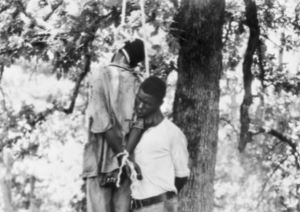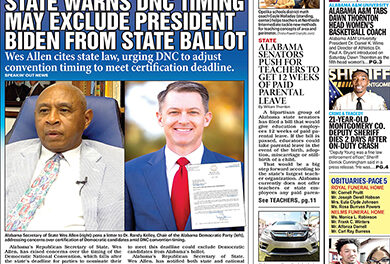
By BRITTANY N. GADDY
The Howard Center for Investigative Journalism
COLUMBUS, Miss. — In a roughly 150-square-foot room on the second floor of The Commercial Dispatch, the newspaper of record for Columbus and surrounding Lowndes County, Mississippi, are large, heavy bound volumes of old newspapers stacked on wooden shelves.
They date back to at least 1922, when Vinton Birney Imes Sr. merged his two newspapers — The Columbus Commercial and The Columbus Dispatch — into the newspaper of today. The publication has been passed down through four generations from Imes Sr. to his son, Birney Imes Jr., to his son, Birney Imes III, and to his son, Peter Imes, the current publisher.
Inside the pages are decades of coverage of the dreams and aspirations, triumphs and tragedies, frailties and failures and laughter and tears of the ancestors of this mostly rural community of nearly 60,000 people: the daily chronicling of a community’s life.
The Commercial Dispatch documented the opening of the Varsity theatre, garment plant employees returning to work, the county’s vote to legalize beer, the tragic death of a Lowndes County farmer and the county’s efforts to be a part of a soil erosion project.
Then there are those other stories published by the paper and its predecessors: the editorial praising the Klu Klux Klan, a racist caricature of an old Black man that ran daily on the front page, a letter to Mississippians supporting white supremacy and the stories that reported and condoned the lynchings of Black men.
Lynchings were a form of racial terror, said historian Elijah Gaddis, an assistant professor of history at Auburn University.
No state used the tactic more than Mississippi. It led the country with at least 673 lynchings, according to an analysis of the Beck-Tolnay Inventory of Southern Lynch Victims by the Howard Center for Investigative Journalism at the University of Maryland.
Lowndes County, located in eastern Mississippi right on the border with Alabama, accounted for 20 of those murders, the analysis shows.
The white press was not an innocent bystander in these gruesome murders. Instead, The Commercial Dispatch and other white-owned Mississippi newspapers cultivated an environment where the lynchings of African Americans were socially acceptable.
Contributing to the climate of racial terror in Mississippi and other states was the landmark 1896 U.S. Supreme Court decision in Plessy v. Ferguson, which upheld racial segregation.
Two years later, the Court held in Williams v. Mississippi that literacy tests and other barriers to voting for African Americans “do not, on their face, discriminate between the white and negro races.”

The bodies of Dooley Morton (L) and Bert Moore, of Lowndes County, are shown hanging from a tree after the two were lynched by an angry mob of white citizens on July 15, 1935, near Columbus, Mississippi. They were torn away from police officials, who arrested the men when a white woman identified the pair as the ones who had made the attempt to criminally attack her. (Photo by O.N. Pruitt via Getty Images)
“I think that at the turn of the century, Mississippians were very pleased with how the rest of the country was coming around to their thinking,” said Shennette Garrett-Scott, an associate professor of history at Texas A&M University. “They are completely unafraid of using violence to reinforce the intent of those laws … and to force Blacks into that social etiquette.”
Thirteen African Americans were lynched in Lowndes County after Reconstruction, between 1884 and 1906, according to a Howard Center analysis of the Beck-Tolnay Inventory of Southern Lynch Victims.
Before they were combined into The Commercial Dispatch on March 12, 1922, The Columbus Dispatch and The Columbus Commercial were the newspapers for Lowndes County. Both reported on the 1906 lynching of George Colvin, a Black man.
The Columbus Dispatch reported in its May 24, 1906, edition that Colvin, who was also known as George Younger, was suspected of burglarizing a store on May 19, 1906.
When a white posse looking for Colvin broke into his cabin, the newspaper reported that Colvin shot one of the men and escaped. He was eventually captured, the paper said, and was expected to be brought back to stand trial. Instead, he was lynched by an Alabama mob. The exact date of his lynching is in dispute.
By being lynched, The Columbus Dispatch wrote, Colvin had “gone the way of all bad negroes.”
In the same article, the newspaper wrote, “For reasons which are good and sufficient, people who are present at lynchings do not talk freely to newspaper men regarding what transpires on occasions of this kind, so it is impossible to accurately describe the proceedings which took place.”
The county’s other newspaper, The Columbus Commercial, on May 29, 1906, called members of the mob who lynched Colvin “eighteen good citizens of West Alabama.”
None of the stories reviewed by the Howard Center in either newspaper named the people who committed the murders.
White-owned newspapers had “no vested role in outing members of their community as perpetrators,” said historian Jason Morgan Ward, a professor of history at Emory University in Atlanta. “They (didn’t) want to provide any information in most cases that would aid an investigation or that would promote any kind of deep dive into what actually happened.”
The Columbus Commercial and The Columbus Dispatch rarely, if ever, published positive coverage of the Black community.
The same day The Columbus Commercial condoned the mob that lynched Colvin, it printed an article from the New York Press in which a Black preacher and pugilist was referred to as an “old darkey” and was quoted speaking in broken English.
Days before Colvin’s lynching, The Columbus Dispatch printed the views of Charles Francis Adams on its editorial page titled, “What He Thinks of the Negro Problem. The Result of His Study of the Negro in Africa.” One of Adams’ conclusions regarding African Americans was “contact with the white man is necessary to keep the negro from retrogression.”
On Sept. 5, 1907, the Dispatch reported on the Aug. 28 lynching of John Gibson, a Black man, in Pickens County, Alabama. According to the newspaper, he assaulted a white woman.
Under the headline “A NEGRO FIEND MEETS HIS FATE,” the newspaper wrote Gibson “met the preordained fate of all such fiendish brutes on the following day, having been hanged to a tree and riddled with bullets by a posse of righteously indignant citizens.”
Charlie Harris, Gibson’s uncle, was not accused of any crime but was also lynched, The Columbus Dispatch reported.
Harris was lynched, the newspaper said, because he “was a negro of turbulous temperament, and after his nephew had been lynched exhibited a loaded gun and indulged in remarks calculated to arouse a revolt on the part of the negroes.” The paper said, “The white citizens decided to quell the threatened insurrection in its incipiency, and Harris was quietly put out of the way.”
Again, in the stories reviewed, none of the assailants were identified and the paper did not run any stories in which it sought their names. Sometimes, in the same story as the lynchings, there was a report of a judicial inquest in which it was ruled the victims were lynched by parties unknown.
During the period when Gibson and Harris were lynched, The Columbus Dispatch printed a letter from C.M. Williamson, chairman, and Garard Harris, secretary, of The Vardaman State Committee. Their letter urged Mississippi residents to vote for James K. Vardaman, then the governor of Mississippi, for U.S. senator. Vardaman previously said, “If it is necessary, every Negro in the state will be lynched; it will be done to maintain white supremacy.”
The letter said the 15th Amendment, which gave Black men the right to vote, “was in the nature of a political crime.” It also said Vardaman’s election “would be a fresh notice to the negro at home and elsewhere that Mississippians never intended to furl the flag of white supremacy.”
On March 5, 1922, an editorial in The Columbus Dispatch answered a question: “Why don’t you say something in the Dispatch against the Ku Klux Klan?”
The editorial stated: “we expect to see the day dawn when men who are now denouncing the Ku Klux will be raising their hands to Heaven and imploring God to send the Ku Klux, or an organization similar to it, to deliver them and their children from black supremacy, the boot-leggers, and certain other forms of outlawry that can only be reached and punished by secret means.”
Days later, on March 12, 1922, The Commercial Dispatch published its first edition after the merger of The Columbus Dispatch and The Columbus Commercial. But the tone of coverage did not change.
A week after the merger, the paper reported the lynching of Jerry Ingraham, a Black man accused of assaulting a white woman. It stated “the negro brute failed to accomplish his purpose.”
The Commercial Dispatch reported Ingraham was captured in Columbus and lynched in Noxubee County, Mississippi, on March 17, 1922.
In 1933, Jesse Patterson, a Black man who confessed to killing a white couple, was also called a negro brute in an editorial by The Commercial Dispatch. He was later convicted for killing the woman and executed, according to The Commercial Dispatch.
A review of dozens of newspapers found labeling Black men as negro brutes was a common practice of the white press.
Elaborating on the use of that language by white-owned newspapers, historian Charles K. Ross, a professor of history and African American Studies at the University of Mississippi, said “it’s almost as though you can’t deal with these people in any kind of humane way. You (have) to deal with them in a very violent way.”
Three days after The Commercial Dispatch’s editorial labeling Patterson a negro brute, the hanging of an unknown Black man near Caledonia, a Lowndes County town, was reported by the paper on July 23, 1933.
Law enforcement officers stated the man was lynched because he was “alleged to have ‘insulted a white woman,’” The Commercial Dispatch said. The newspaper reported officers said the unidentified man attempted to set up a date with a white woman, but when he went to meet her, he found a “band of men” instead.
According to The Commercial Dispatch, Deputy Sheriff Homer Kilpatrick said the lynching had not been officially reported, no investigation had been made by his office, and “apparently no action would be taken by authorities.”
There were numerous other instances of biased reporting by The Commercial Dispatch, too.
On Oct. 7, 1931, The Commercial Dispatch reported that Coleman Franks, a Black man also known as Coleman Hooper, was charged with assault and battery with the intent to kill Clyde Bell, a white man.
Next to the article detailing Franks’ arrest is a “Hambone’s Meditations” cartoon — a demeaning caricature of a Black man speaking in broken English. It ran in many white-owned newspapers and daily on the front page of The Commercial Dispatch until March 3, 1942.
Weeks after Franks’ arrest, The Commercial Dispatch reported he was found hanging from a tree. It also said an inquest found he “had met violent death at the hands of parties unknown.”
The article quoted Bell’s neighbors as stating that Franks had the intent to kill Bell. Missing from the article were interviews with people who knew Franks, which is contrary to today’s common journalism practice of including all perspectives in a story.
The Commercial Dispatch’s past lynching coverage was “not from a perspective of today,’’ said Berkley Hudson, an emeritus associate professor of the University of Missouri’s School of Journalism and author of a forthcoming book about photographer O.N. Pruitt’s documentation of Lowndes County and the American South. “The mainstream White press did not do its duty,” Hudson said.
In 1935, The Commercial Dispatch editorialized against proposed anti-lynching legislation in Congress. It referred to it as a “direct slap at the South.”
“If the time ever comes when the federal government begins to take a hand in racial relations, as was attempted by the Wagner-Costigan anti-lynching bill, trouble, and serious trouble at that, is going to ensue,” the editorial said.
Months later, The Commercial Dispatch reported the double lynchings of Bert Moore and Dooley Morton in its July 15 and July 16, 1935, editions.
The July 15 headline stated: “TWO NEGROES PAY FOR ACT ON TREE LIMB.” Moore and Morton, two Black men, were accused of attempting to attack a white woman. They were hanged “from the limb of oak tree near Zion negro church” close to Columbus, Mississippi, by a mob of about 35 men in six automobiles who took Moore and Morton from Deputy Sheriff Parker Harris, The Commercial Dispatch wrote.
Harris was transporting the men to a safer location in Aberdeen, Mississippi, when he was accosted, the newspaper reported.
The next day’s edition, under the front-page headline “LYNCH EPISODE IS CLOSED HERE,” revealed that Moore and Morton’s bodies were left hanging near the church for more than 12 hours and a judicial inquiry returned the verdict that they died by “‘hands of unknown parties,’” the paper said.
Both front-page stories were removed from the July 15, and July 16, 1935, editions of The Commercial Dispatch stored in the newspaper’s archives.
The Commercial Dispatch continued racist policies in its news coverage through the late 1960s and early 1970s.
Pat Ross, a former managing editor of The Commercial Dispatch in the 1970s, said when she worked in the society pages earlier in her career at the newspaper “no Black news was in the newspaper unless they committed a crime.”
“There was never any question that Black weddings or Black clubs or any of those kinds of things would be placed in a predominantly white-based newspaper,” Ross said. “The Black community had their own newspapers.”
One of those papers was The Columbus Sun, a Black-owned newspaper established in 1952, which was in operation for over 50 years.
The policy didn’t change until Ross, then a city editor, approached Birney Imes Jr., then the paper’s publisher, in the late 1960s or early 1970s about adding Black wedding announcements to the society pages. Imes agreed to publish white wedding announcements in one day’s edition and Black wedding announcements in another day’s edition.
To the best of Ross’ knowledge, she said, featuring Black and white wedding announcements on different days was done to minimize controversy in the community due to integration.
“With a newspaper, you have to maintain your readership,” Ross said. “Lose your readership, you lose your advertisers, and if you lose your advertisers, you lose your newspaper.”
Several newspapers have published apologies for their coverage of lynchings and racial terror, including The Montgomery Advertiser, The Los Angeles Times, The Kansas City Star, the Orlando Sentinel and The Capital newspaper in Annapolis, Maryland.
The Commercial Dispatch has not.
Peter Imes, publisher of The Commercial Dispatch, declined to be interviewed about the newspaper’s coverage of lynchings and racial terror. Instead, he emailed a statement.
“The Commercial Dispatch has taken unfortunate, harmful positions with regards to race in the distant past,” Imes said in his statement. “For at least the past three decades, this paper has dedicated itself to providing holistic coverage of the communities we serve.”
In June 2021, The Commercial Dispatch won the General Excellence Award for medium-sized dailies at the annual Mississippi Press Association Better Newspaper Contest. The publication received 26 awards, including 10 first-place prizes, in that contest.
Lowndes County Supervisor Leroy Brooks, an African American, said The Commercial Dispatch has improved its coverage of the Black community.
Brooks said he felt decades ago The Commercial Dispatch treated him unfairly in its editorials and stories. “And I think as elected officials came behind me, some of them had to also bear that brunt. And I don’t see that being the case now,” he said.
The paper has moved away from negative “reporting of Black people, events and other things in the community,” he said. “(They’re) insinuating more of the positive. I think that they have lessened their hardcore approach in writing about Black elected officials and other Black leaders. And this has not always been the case.”
Help us Continue to tell OUR Story and join the AFRO family as a member – subscribers are now members! Join here!
The post Columbus, Mississippi, newspapers were not innocent bystanders to racist violence appeared first on AFRO American Newspapers .











